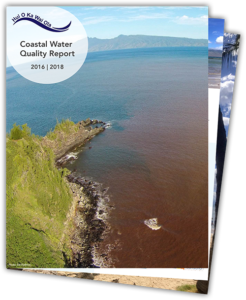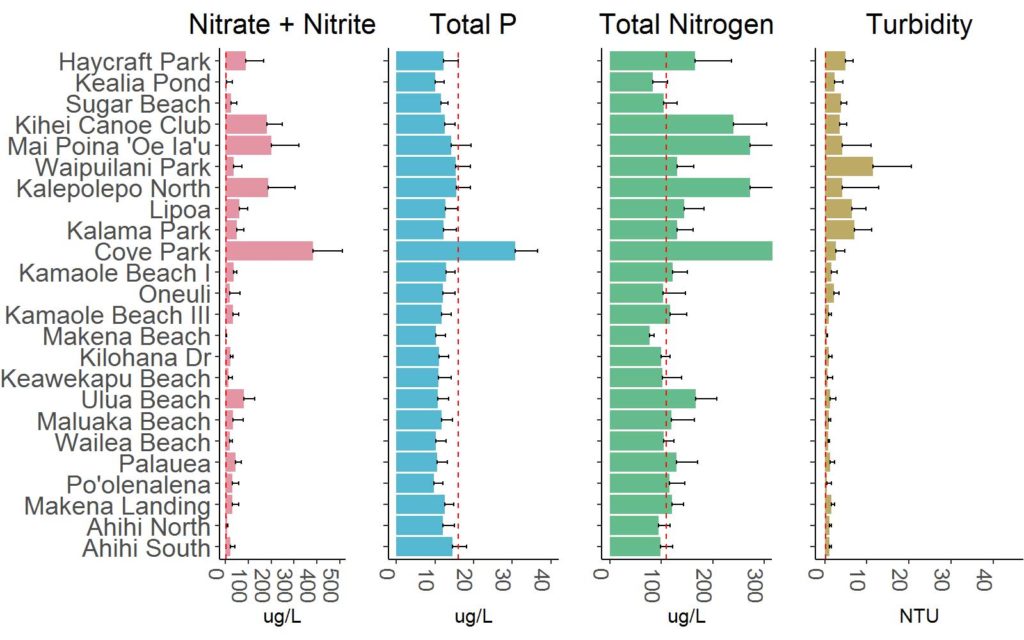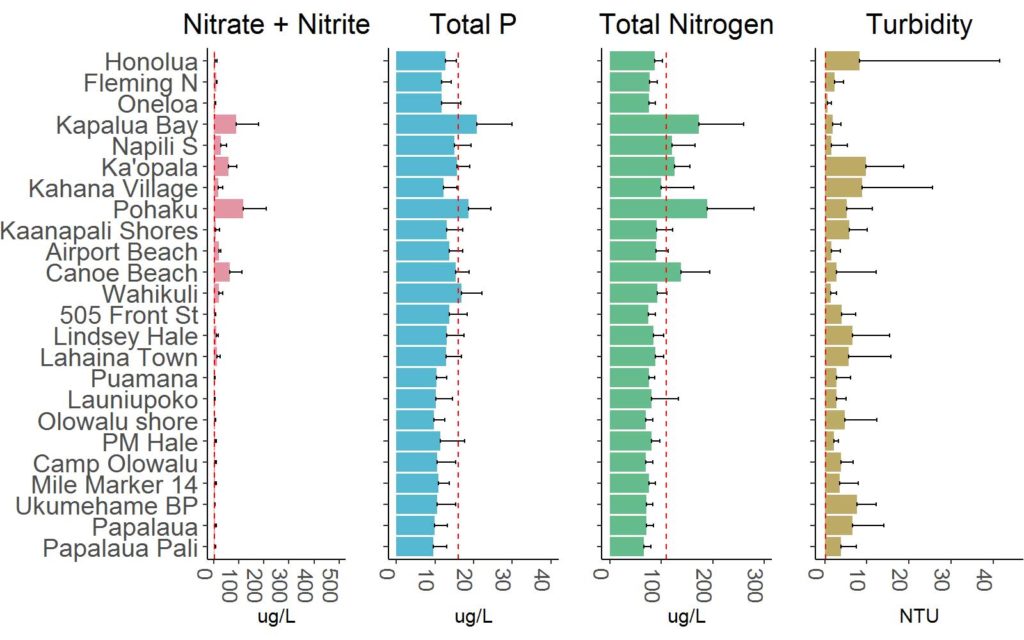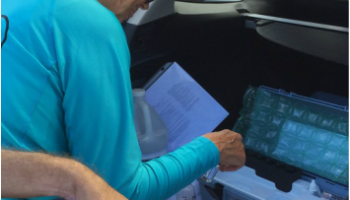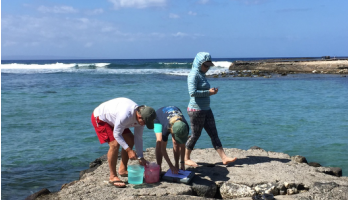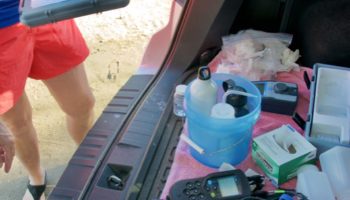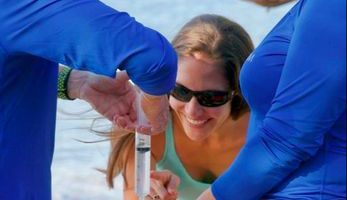Clean ocean water is essential for healthy coral reefs. It’s also important to visitors and residents who enjoy swimming, snorkeling, diving, paddling, fishing and surfing along Maui’s coasts.
Maui Nui Marine Resource Council is proud to be a major partner in an innovative community-based water quality monitoring program called Hui O Ka Wai Ola (Association of Living Waters).
We are monitoring water quality during COVID-19
Our Hui O Ka Wai Ola program had taken a brief break from mid-March to May due to safety concerns during the COVID-19 pandemic. Once we received permission from Maui County officials to continue this essential work, we were able to resume our monitoring schedule. We are monitoring all of our leeward Maui sites every three weeks.
Filling an important need
The Hui O Ka Wai Ola program is a living breathing example of how nonprofit organizations can effectively work with government agencies to stretch the agencyʻs resources and capabilities.
Maui Nui Marine Resource Council, The Nature Conservancy and West Maui Ridge to Reef Initiative co-founded and co-manage the Hui O Ka Wai Ola program to support the State of Hawaiʻi Department of Health Clean Water Branch. We are supported by grants and contributions from companies and businesses, as well as individuals and families who share our commitment to clean ocean water. View our sponsors.
Together with the help of more than 40 volunteers from the community, Hui O Ka Wai Ola has greatly expanded the Department of Healthʻs ability to test ocean water quality at Maui beaches and to provide quality-assured data to County, State and Federal agencies.
We add to the data collected by the Department of Health with our testing that keeps a close eye on changing water quality conditions that can harm our coral reefs.
Our community-based program regularly gathers data about sediment, nutrients in the water, temperature, pH and more along Mauiʻs south and west shores. In 2018, our program expanded to include 41 locations. In 2019, we expanded our program to include testing for enterococcus bacteria at our South Maui testing sites.
As of August 2020, our Hui O Ka Wai Ola program has gone from monitoring 41 to 33 sites. After looking closely at the data our volunteers have gathered since June 2016, our Hui O Ka Wai Ola Technical Committee recommended eight sites to “pause” and one site to discontinue for one or more of the following reasons: we have a good understanding of their water quality dynamics, these sites have little to no pollution or fluctuation, no management is currently underway for contributing land based pollution, and/or no permanent funding is available to continue monitoring these sites.
The Technical Committee also added one site, Kahekili Two, which is north of the previously monitored Kahekili Beach Park site and is closer to the influence of the Lahaina Wastewater Treatment facility.
The committee made additional adjustments in September 2021. We are now monitoring 29 sites in South and West Maui for nearshore water quality.
Part of this shift to monitor fewer sites allows our program to expand into some other water quality research, such as source detection, including limu nitrogen isotope testing, and working with partners to delve deeper into some of the pollution “hot spots” our data has helped identify. More on this to come!
We believe this data will allow for more effective management of our nearshore waters and ultimately, healthier coral reefs and cleaner ocean water for all to enjoy.
CURRENT WEST MAUI SITES:
Honolua Bay
Napili Bay
505 Front St.
Oneloa Beach
Pōhaku Park
Kauaula Rd. (Lindsey Hale)
Kapalua Bay
Kā’anapali Shores
Lāhaina Town
Ka’opala Bay
Kahekili Beach Two
Camp Olowalu
Kahana Village
Hanaka’ō’ō Park (Canoe Beach)
Pāpalaua Pali
Wahikuli Park
CURRENT SOUTH MAUI MONITORING SITES
Ma’alaea Harbor
Ma’alaea Condos
Kalepolepo Park
Cove Park
Waipuilani Park
Maluaka Beach
Haycraft Park
Kīhei South (W. Lipoa St.)
Keālia Pond
Kalama Park
‘Āhihi-Kīna’u North
’Āhihi-Kīna’u South
Kīhei Canoe Club
View comparisons of our results by site:
South Maui
West Maui
Note: the red dotted lines indicate standards set by Hawaii’s Department of Health Clean Water Division.
What We Test For
Turbidity
How it is measured: We gather samples at knee depth, then use a turbidity meter onsite to measure the amount of sediment (turbidity) in the water.
How changes are caused: Sediment carried from the land to the ocean (by streams, flooding, storm runoff) can cause ocean water to become brown or murky.
Why it is a concern: Sediment blocks sunlight from reaching reefs and can smother corals.
What we can do: When we find areas with high levels of turbidity, we can address upslope issues such as grading or clearing of land that caused sediment to flow into the ocean.
Ocean chemistry
How it is measured: We measure pH, salinity and water temperature onsite using portable, handheld equipment.
How changes are caused: Changes in ocean chemistry can be caused by climate change and other local factors. Salinity can be changed by freshwater flowing into the ocean. Water temperature can fluctuate by season and can also be caused by climate change. Ocean acidity can be increased warming ocean temperatures. Warmer water also holds less dissolved oxygen (needed for aquatic plants and animals to survive).
Why it is a concern: Corals are very sensitive to changes in ocean chemistry, including increased ocean water acidity. Corals bleach when water temperature increases; collecting water temperature can help track localized variations between sites.
What we can do: We can monitor changes in reef health against changes in ocean water quality and continue to advocate for ways to reduce greenhouse gases and reverse climate change.
Nutrients (nitrogen and phosphorous)
How they are measured: Water samples are gathered, refrigerated and shipped on ice to the SOEST Analytical Laboratory on Oahu for analysis of nitrogen and phosphorous.
How changes are caused: High levels of nitrogen and phosphorous can indicate pollution from wastewater, run-off from agriculture, landscaping and/or golf courses.
Why itʻs a concern: Too much nitrogen can cause an increase in invasive algae (limu), which is damaging to coral reefs.
What we can do: When we identify ocean areas with high levels of nutrients, we can pinpoint and address up-slope areas that are sources.
Bacteria
How it is measured: Water samples are gathered in sterile bags, which are then sealed and refrigerated. Samples are shipped on ice to regional labs, where they are analyzed for Enterococcus bacteria.
How it is caused: Bacteria may result from wastewater pollution. Enterococcus bacteria also live in soil and can be carried into the ocean via runoff.
Why itʻs a concern: Enterococcus bacteria are generally not harmful by themselves but do indicate the possible presence of pathogenic (disease-causing) bacteria, viruses, and protozoans that also live in human and animal digestive systems.
Where We Test
WEST MAUI
Honolua Bay
Napili Bay
505 Front St.
Oneloa Beach
Pōhaku Park
Kauaula Rd. (Lindsey Hale)
Kapalua Bay
Kā’anapali Shores
Lāhaina Town
Ka’opala Bay
Kahekili Beach Two
Camp Olowalu
Kahana Village
Hanaka’ō’ō Park (Canoe Beach)
Pāpalaua Pali
Wahikuli Park
SOUTH MAUI
Ma’alaea Harbor
Ma’alaea Condos
Kalepolepo Park
Cove Park
Waipuilani Park
Maluaka Beach
Haycraft Park
Kīhei South (W. Lipoa St.)
Keālia Pond
Kalama Park
‘Āhihi-Kīna’u North
’Āhihi-Kīna’u South
Kīhei Canoe Club
Our partners
Hui O Ka Wai Ola works closely with the State of Hawaii Department of Health (DOH). The program is managed by these nonprofit partners:
- Maui Nui Marine Resource Council (MNMRC)
- The Nature Conservancy (TNC)
- West Maui Ridge to Reef (R2R) Initiative


